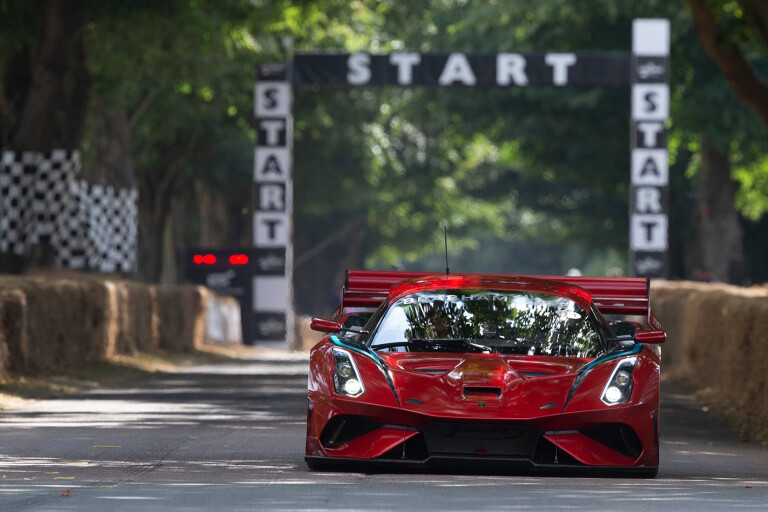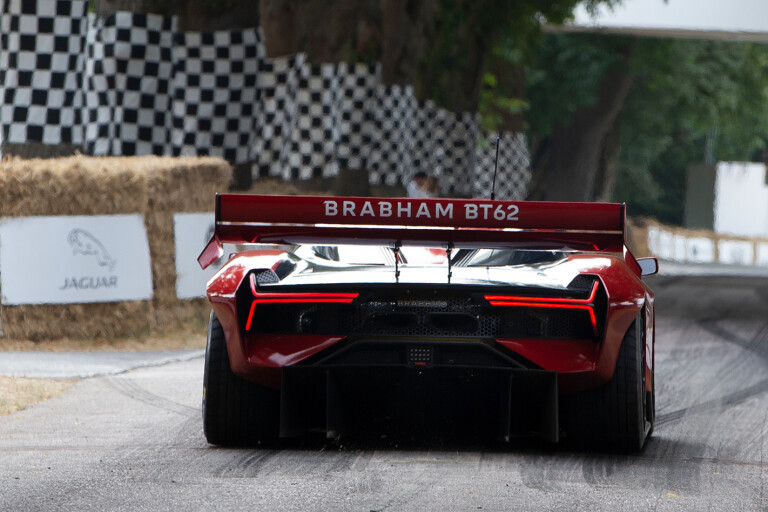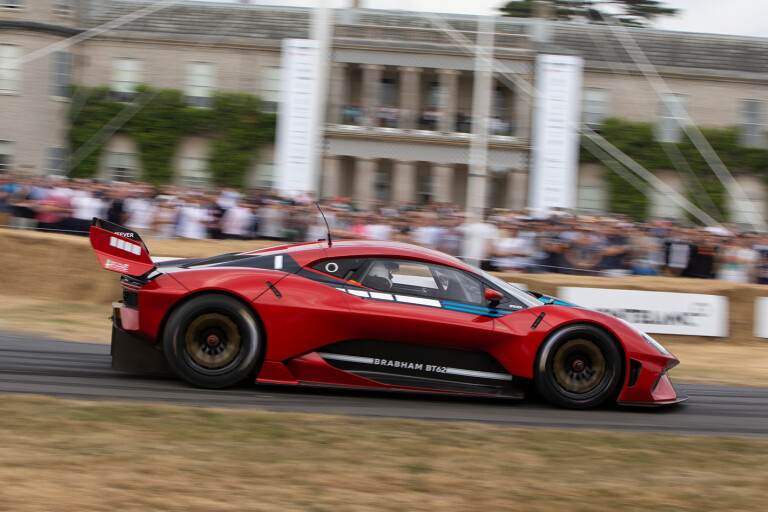
In the tech industry, ‘vapourware’ describes products that get hyped but never actually appear. Sadly, most sports car start-ups deserve the same description. Too often we get a press release announcing a new player or the rebirth of a famous old name, a launch party and an image or a clay model, but ultimately no car.

But the only vapour emanating from Brabham Automotive is curling gently from the twin tailpipes of its new BT62 track car as it idles on the start line at the Goodwood Festival of Speed, just three months after it was unveiled at Australia House in London. David Brabham is already strapped in, and motions me into the passenger seat. “Come on in, mate,” the Le Mans winner says. “Welcome to the office. Sorry it’s so bloody hot.”
The recent welter of low-volume, high-power, extreme-price track-only specials from the established supercar makers might feel a little irrelevant to most of us, but the Brabham may have caught your attention for a) coming from the family of Black Jack, Australia’s greatest-ever racing driver, and b) being built in Adelaide just as the rest of Australian car-making shuts down. After the Agera, the Senna and the Huayra, the Shraya would have made a good name for an Aussie-built supercar. But the BT62 continues the Brabham Racing naming convention that ran from 1961 to the stillborn BT61 of 1992, and seems appropriate given Brabham’s plan to return to racing with a Le Mans entry using a variant of this car in a couple of years. A road car could follow within five.

So the BT62 is a race car made slightly more accessible, rather than a road car made more extreme like the Senna GTR. It has a steel space-frame chassis with carbon panels, is powered by a 5.4-litre atmo V8 making 522kW and 667Nm, and drives the rears through a six-speed Holinger sequential gearbox. The block is sourced from an OEM but so heavily modified they’ve taken their name off it, and it’s billed as a Brabham engine. David won’t say where it’s from, but the rumours say Ford. It only has 932kgs to shift, but also the drag required to generate 1200kgs of downforce with a lot of passive aero.
Look past the brutal wing and splitter and there’s a pretty shape beneath, with hints of McLaren in the rear haunches and BMW i8 in the detached bodywork forms around the pinched-in waist.
This is one of two running prototypes: 70 will be made, with the first 35 offered in the liveries of Brabham’s 35 F1 winners. This one bears the colours of Gordon Murray’s mad BT46B ‘fan car’, which won once at Anderstorp, Sweden, 40 years ago before being banned. It was one of Brabham’s finest moments, and the livery is playing well with a knowledgeable Goodwood crowd. The weave of the carbon bodywork is clearly visible through the paint, as it was on the bonnet of an F40 30 years ago. You wouldn’t find that on a McLaren, but there’s a pleasing, race-car honesty and simplicity about it, and it won’t change for production.

To get in you fling the featherweight, carbon and acrylic door wide open and lever yourself past the roll cage, though the aperture itself is big enough to be practical. The cockpit is stark, of course. The seats are nearly recumbent. David has a rectangular race ‘wheel’ ahead of him with the usual buttons and manettini, and 3x5 block of switches angled towards him from the central console. There’s a 12.0-inch instrument screen ahead of him with expensive-looking graphical clarity, good enough for a ‘normal’ supercar. Below that are a knob to adjust the brake bias and a lever to move the pedal box, which is a small work of engineering art on its own, set on a little carbonfibre plinth so your heels can rest at the right height without the weight of a complete false floor.
I’m not about to give you a definitive verdict based on a one-minute fang up the hill at Goodwood and a leisurely descent, mostly in neutral. But you still learn plenty. Beyond the simple fact that Brabham kept the project so secret and have delivered a running prototype so soon, it’s impressive that the car will do eight runs up the hill today in 30-degree heat and stop-start conditions less than perfect for a race car without missing a beat. As David rolls us up to the start line it’s also much more refined than I was expecting, with less noise and fizz from the engine penetrating the cabin, and less of a thwack to the back of the head as the gears go in.
The BT62 may have road-car manners, but as the marshals wave us off it’s instantly obvious that it’s race-car fast. The clutch is only required to get the car away, and David rolls us off the line before getting deep – though probably not all the way – into the throttle. Still, he and his car are plainly ohhhhhh-shit quick, the revs on that big display still leaping up long after anyone sensible would have braked for the looming first right-hander. Just as I’m taking a possibly final look down at my legs he hits the six-pot carbon-ceramic stoppers and we’re dancing through the corner before getting hard on it again up the straight outside Goodwood House. The noise never gets shrieky or painful: just a lovely, loud, old-school V8 rumble overlaid with the whine of the transmission. With the Ohlins dampers providing a sweet ride over Goodwood’s imperfect tarmac, the complete experience is terrifying but surprisingly comfortable, like sitting in premium economy in a freefalling aircraft.

But is it worth $1.8m, before taxes? The good news is that there’s no luxury import tax to pay, as the BT62 is made in Australia, and not legally a car anyway.
You’re also not just paying for the car but for a driver development program with four days each on four different tracks and David giving the instruction. Because Brabham hasn’t (yet) built a road car of its own, few people have driven one, so you’re joining a very select and often fairly famous club. And judging from the way David is mobbed as he tries to walk around Goodwood, that name, once on a par with McLaren and Lotus and Ferrari, still counts for a lot.

COMMENTS